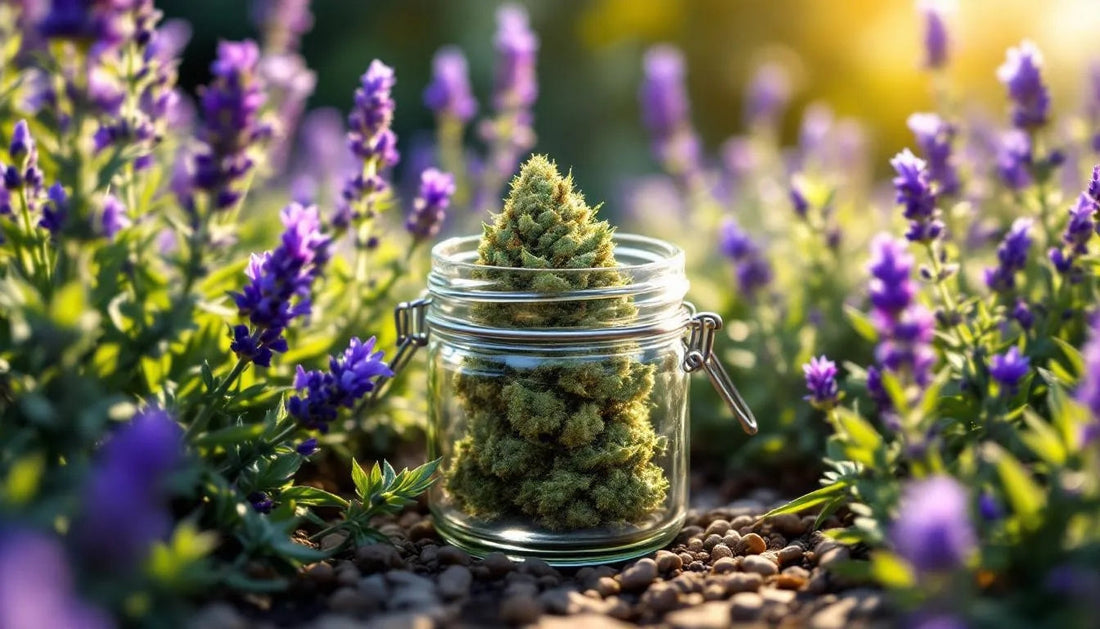
How to Hide Weed Smell: The Complete 2025 Guide to Cannabis Odor Control
Cannabis has a distinctive, potent aroma that can linger for hours and travel far beyond your intended space. Whether you're a medical patient, recreational user, or indoor grower, understanding how to hide weed smell effectively ensures privacy, maintains good relationships with neighbors, and helps you stay compliant with local regulations. This comprehensive guide covers 15 proven methods for controlling cannabis odors during cultivation, consumption, and storage.
Understanding Cannabis Smell: The Science Behind the Scent
Cannabis produces its distinctive aroma through organic compounds called terpenes, which develop in the plant's trichomes alongside cannabinoids like THC and CBD. These aromatic molecules evolved as a defense mechanism against pests and environmental stressors. Different strains contain varying terpene profiles, creating scents ranging from citrusy and fruity to earthy and skunky.
The intensity of cannabis odor depends on several factors including strain genetics, growing conditions, curing quality, and consumption method. Plants grown with premium nutrients like Lotus Pro Series Boost often develop more pronounced terpene profiles, requiring stronger odor control measures during cultivation and after harvest.

Pre-Consumption Odor Prevention Strategies
Strain Selection for Minimal Odor
Some cannabis strains naturally produce less pungent aromas than others. Low-odor strains typically contain higher concentrations of subtle terpenes like linalool and bisabolol rather than strong-scented compounds like myrcene or caryophyllene. Research strain terpene profiles before cultivation or purchase if discretion is your primary concern.
Proper Storage Solutions
Airtight storage is your first line of defense against unwanted cannabis odors. Glass jars with rubber gasket seals, vacuum-sealed bags, or specialized cannabis storage containers prevent smell molecules from escaping. Store containers in cool, dark locations away from high-traffic areas where accidental odor release might be noticed.
Location Planning and Timing
Choose consumption locations strategically, considering wind patterns, ventilation, and proximity to neighbors or sensitive areas. Timing matters too – consuming during windy conditions or when neighbors are typically away reduces the likelihood of complaints or awkward encounters.
Advanced Air Filtration and Ventilation Systems
Carbon Filter Technology
Activated carbon filters represent the gold standard for cannabis odor elimination. These filters work through adsorption, trapping odor molecules in millions of tiny pores within the carbon structure. For growing operations, inline carbon filters connected to exhaust systems can eliminate up to 99% of cannabis odors before air exits your space.
Professional growing setups often integrate carbon filtration with complete ventilation systems to maintain optimal growing conditions while controlling smells. This becomes particularly important when using high-quality nutrients like Lotus Bloom Nutrients that enhance terpene production during flowering.
HEPA and UV-C Air Purifiers
High-efficiency particulate air (HEPA) filters remove smoke particles from the air, while UV-C light systems break down odor-causing molecules at the molecular level. Combining both technologies creates a comprehensive air cleaning system that addresses both visible smoke and lingering odors.
Strategic Fan Placement
Proper airflow management prevents odor accumulation and speeds smell dissipation. Position oscillating fans to create air circulation patterns that move odorous air toward filtration systems or exhaust points. Avoid creating dead air zones where smells can concentrate and linger.
Immediate Smell Masking and Neutralization Techniques
Natural Odor Absorbers
Several natural materials effectively absorb cannabis odors without creating suspicious artificial fragrances. Activated charcoal, baking soda, and white vinegar all work through different mechanisms to neutralize smell molecules. Place bowls of these materials strategically around consumption areas for passive odor control.
Coffee grounds, both fresh and used, contain natural compounds that neutralize many organic odors. Citrus peels provide a fresh scent while their oils help break down cannabis terpenes. These natural solutions work best in enclosed spaces or as supplementary odor control methods.
Essential Oil Diffusion
Essential oils can mask cannabis odors while providing pleasant, natural fragrances. Eucalyptus, peppermint, and tea tree oils have particularly strong scent profiles that can overpower cannabis aromas. Use diffusers or spray bottles to distribute these scents throughout your space.
However, avoid obviously masking scents that might draw attention. Subtle, natural fragrances work better than heavy, artificial air fresheners that signal you're trying to hide something.
Ozium and Commercial Neutralizers
Commercial odor eliminators like Ozium work by chemically breaking down odor molecules rather than simply masking them. These products prove particularly effective for immediate odor control after consumption sessions. Use them sparingly in well-ventilated areas, as some commercial neutralizers can be harsh on respiratory systems.
Consumption Method Modifications
Vaporization Benefits
Vaporizers significantly reduce odor compared to combustion methods. They heat cannabis to temperatures that release cannabinoids and terpenes without burning plant material, creating vapor instead of smoke. Vapor dissipates faster and produces less lingering odor than combustion smoke.
Quality vaporizers with precise temperature control allow you to minimize terpene release while maintaining desired effects. Lower temperature settings (315-375°F) produce less odor than higher temperature sessions.
Edibles and Tinctures
Non-inhalation consumption methods eliminate smoke and vapor odors entirely. Edibles, tinctures, and sublingual strips provide cannabis effects without any telltale aromas during consumption. However, edible preparation can create cooking odors that require their own management strategies.
Smoking Accessories and Tools
Smoke filters, also called sploofs, reduce odor by filtering exhaled smoke through activated carbon or other absorbing materials. Commercial products like SmokeBuddy offer convenient, portable odor reduction for personal use.
One-hitters and small pipes produce less smoke than joints or large bowls, reducing overall odor production. Using hemp wick instead of butane lighters eliminates chemical odors that can draw attention to cannabis use.
Growing Operation Odor Management
Environmental Controls
Maintaining optimal growing conditions reduces stress-induced terpene production while improving overall plant health. Monitor temperature, humidity, and pH levels consistently to prevent plants from over-producing defensive compounds that increase odor intensity.
Plants grown with balanced nutrition from quality sources like Lotus Cal-Mag for Plants typically produce more consistent, manageable terpene profiles throughout their growth cycle.
Harvesting and Processing Considerations
Fresh cannabis plants produce the strongest odors during harvest and trimming. Plan these activities carefully, ensuring adequate ventilation and filtration systems are operating at full capacity. Consider processing outdoors if possible, taking advantage of natural air circulation.
The drying and curing process requires special attention to odor control, as this is when many terpenes reach peak concentration. Our detailed guide on how to dry weed properly includes specific techniques for managing odors during post-harvest processing.
Growing Equipment and Setup
Professional growing equipment often includes integrated odor control features. Grow tents with carbon filter pre-filters, sealed growing chambers, and negative pressure systems prevent odors from escaping growing areas.
For comprehensive growing setups, consider systems that combine nutrition, environmental control, and odor management. The Lotus Hydroponic Starter Kit provides the nutritional foundation for healthy plants that produce manageable terpene levels when combined with proper environmental controls.
Digital and Smart Odor Control Solutions
Smart Home Integration
Modern smart home systems can automatically manage odor control based on environmental sensors. Smart fans, air purifiers, and ventilation systems can activate when they detect increased humidity, temperature changes, or air quality variations that indicate cannabis use or processing.
Programmable systems allow you to schedule ventilation and filtration based on your consumption or growing schedule, ensuring odor control systems are active when needed most.
Monitoring and Alert Systems
Air quality monitors can detect changes in volatile organic compounds (VOCs) that indicate cannabis odors before they become noticeable to others. These systems can trigger automated responses or send alerts to your phone, allowing proactive odor management.
Some advanced systems integrate with HVAC controls, automatically adjusting ventilation rates based on detected odor levels.
Troubleshooting Common Odor Control Failures
Identifying Odor Sources
Systematic odor source identification helps target control efforts effectively. Common problem areas include inadequate storage, insufficient ventilation, contaminated surfaces, and equipment failures. Regular inspection and maintenance prevent small issues from becoming major odor problems.
Maintenance Requirements
All odor control systems require regular maintenance to remain effective. Carbon filters need replacement every 6-18 months depending on usage intensity. Air purifier filters, fan systems, and ductwork require regular cleaning to maintain optimal performance.
Create maintenance schedules based on your usage patterns and equipment specifications. Preventive maintenance costs less than emergency odor control measures.
Emergency Odor Elimination
Sometimes immediate odor elimination becomes necessary despite best prevention efforts. Emergency protocols might include activating all available air circulation, deploying multiple odor neutralizers simultaneously, and temporarily relocating activities to better-ventilated areas.
Keep emergency supplies readily available, including extra carbon filters, portable air purifiers, and fast-acting odor neutralizers.
Legal and Social Considerations
Neighbor Relations
Maintaining positive relationships with neighbors protects your privacy and prevents complaints that might attract unwanted attention. Consider their schedules, property boundaries, and general attitudes when planning cannabis activities.
Open communication about harmless activities (like "aromatherapy" or "herbal gardening") can prevent misunderstandings without revealing specific details about cannabis use.
Rental Property Concerns
Rental agreements often include clauses about odors and smoking that could apply to cannabis use. Understand your lease terms and local laws before implementing odor control strategies. Some methods, like installing ventilation systems, might require landlord approval.
Document your odor control efforts and maintain systems that can be easily removed if necessary. Focus on methods that don't permanently modify the property.
Frequently Asked Questions About Cannabis Odor Control
What eliminates weed smell most effectively? Activated carbon filters provide the most effective cannabis odor elimination, removing up to 99% of smell molecules through adsorption. Combine carbon filtration with proper ventilation for maximum effectiveness.
How long does cannabis smell linger in a room? Cannabis smoke odor can linger 3-5 hours in still air, while vapor dissipates within 30-60 minutes. Proper ventilation and air filtration can reduce these times significantly.
Can neighbors smell weed from my apartment? Cannabis odors can travel through shared walls, ventilation systems, and hallways in apartment buildings. Use carbon filters, air purifiers, and consume near private ventilation sources to minimize odor travel.
Do cannabis plants smell during growing? Yes, cannabis plants produce noticeable odors throughout their growth cycle, with peak smell production during flowering and harvest. Proper ventilation and filtration are essential for indoor growing operations.
What natural methods hide weed smell best? Activated charcoal, baking soda, white vinegar, and coffee grounds all naturally absorb cannabis odors without creating suspicious artificial fragrances. Essential oil diffusion can provide pleasant masking scents.
Featured Snippet Summary
To hide weed smell effectively: Use activated carbon filters for air filtration, consume in well-ventilated areas, store cannabis in airtight containers, and employ natural odor absorbers like baking soda or activated charcoal. Vaporizers produce less odor than smoking methods, while immediate ventilation and air purification help eliminate lingering smells.
Master Cannabis Discretion with Professional Techniques
Effective cannabis odor control requires understanding the science behind cannabis aromas, implementing appropriate prevention strategies, and maintaining reliable elimination systems. Whether you're growing with premium nutrients like Lotus Grow Series or simply seeking discrete consumption methods, proper odor management protects your privacy and maintains positive relationships with those around you.
Ready to create the perfect discrete growing environment? Explore our comprehensive guides on setting up cannabis grow tents and controlling humidity in grow tents for complete environmental management. For advanced growing operations, check out our detailed cannabis feeding schedule to optimize plant health while managing terpene production. Don't forget to review our existing tips for hiding weed smell and noise reduction techniques for grow tents to create a completely discrete growing operation.
